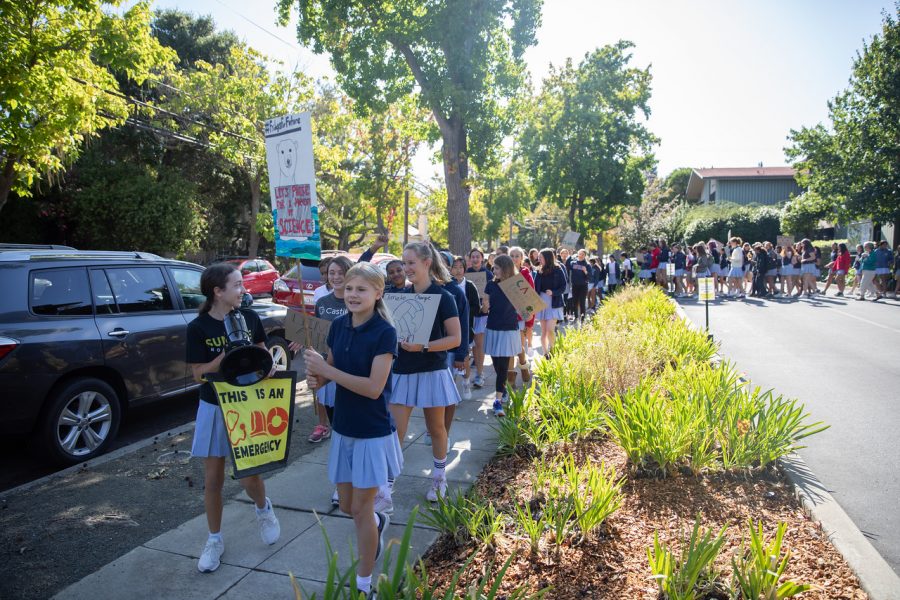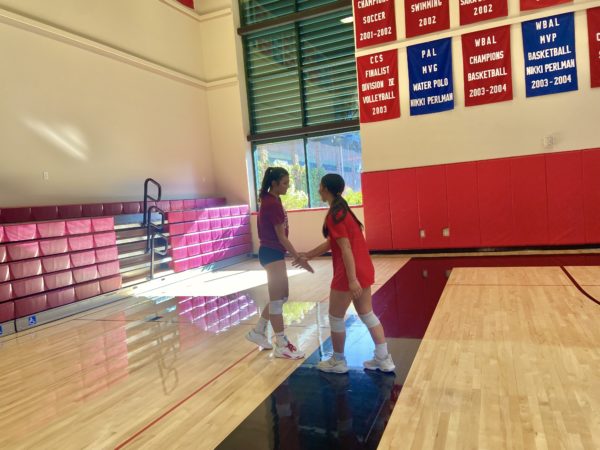It’s 2030, and Palo Alto is a champion of sustainability. Here’s how we got here.
Students marched around campus during Castilleja’s 2019 Global Climate Strike Walkout
I am twenty-four years old today. Three years ago, I graduated from college and am now home, visiting my family in Palo Alto for the winter holiday season. I walk into our kitchen and make pancakes for my younger brother and me on our electric cooktop stove. The aroma of our food cooking is no longer overpowered by the overwhelming smell of gassy sulfur flames. After breakfast, I wave goodbye to my parents who are both working from home today.
I walk outside, past our affordable ten-year-old electric car. This is not a rare sight because now 80% of registered vehicles in Palo Alto are electric. With more public charging stations, it has never been easier to be an EV owner in the Bay Area. The sky is a light blue, and clear aside from a sprinkling of white clouds. There is very little traffic and therefore almost no car exhaust or smog coming from the streets. AQI (Air Quality Index) is no longer a burden or concern outside of the wildfire season.
I get on my bike for a morning ride through the city. I head downtown, passing houses on Melville that have been retrofitted to help lower residential emissions; they have solar panels on their roofs as well as electric heat-pump systems and appliances. I loop back around down Hopkins and pass the Rinconada Library. The public garden next to the Library built several years ago has continued to bloom and grow into a beautiful, flourishing, and tranquil public space for Palo Altans and visitors. By now, the majority of city-owned buildings have been fully electrified.
I pass by a family walking their two dogs on the sidewalk. An electric Ford SUV slowly passes us. I continue biking on the wide, brightly colored bike lane past three young kids, none of us having to worry about traffic. I take a loop around the bustling and full Rinconada Park and tennis courts, return home, and park my bike.
I take a moment to reflect on the vast and incredible changes, reach codes (energy policies that “reach” ahead of state requirements), and retrofits that have been made in Palo Alto to reduce greenhouse gases and protect our natural environment.
Palo Alto has become a leader on climate, implementing its influential Sustainability and Climate Action Plan (S/CAP). We set and met our primary goal commonly referred to as 80×30 which meant reducing greenhouse gas emissions by 80% from 1990 levels by 2030. There were considerable challenges along the way, city staffers worked tirelessly and our people made sacrifices.
In late 2019, the City began the process of receiving residential feedback on the draft S/CAP Update. An outpouring of city-wide support from residents, organizations, and climate advocates pushed the City and Council to invest large amounts of time and resources into this endeavor. However, during the Spring of 2020, it became increasingly apparent to residents and advocates that progress on the S/CAP was stifled and there had been a lack of changes since the legislation was introduced four years past. As the COVID crisis receded, the Council and staff recognized this lull and pushed harder for the plan to be approved and implemented. Despite budget cuts, financial difficulties, and the pandemic, Palo Alto did not compromise its climate ambitions.
Everyone involved in this process was aware of the urgency and importance of this legislation. Climate change threatened our natural environment, buildings near flood zones, and the developing lungs of children (from wildfire and smoke exposure). By 2022, some of the main goals of the S/CAP were steadily being fulfilled. For example, the City built more public EV infrastructure, bicycle rack parking, and wider bike lanes. A Sea Level Rise Adaptation Plan had already been procured and was pending Council approval. The short and middle-term initiatives in the City’s 2018 Zero Waste Plan were being implemented. In addition, the city provided more advanced outreach and aid to families struggling to electrify their homes and transition away from gas appliances.
Some residents resented the mandates for electric appliances in their new homes, while others refused to consider electric vehicles. Understandably, the COVID-19 pandemic stifled the use of public transportation, causing more cars to occupy the streets. By 2022 though, public transit filled up again, while bike and walking routes continued to be widely used. Throughout the course of 2022-2024, Palo Alto residents voted on several progressive energy mandates. Strong advocacy from Palo Alto’s leaders diminished the anger of some residents about making these new changes.
As the threat of COVID-19 eased and residents regained financial stability, Palo Alto began funding and devoting resources to organizations focused on aiding those who were most negatively impacted by the climate crisis. The city offered support to several organizations including the California Environmental Justice Alliance and Youth United for Community Action, who had been working hard for many years on the issue of climate and social justice.
Finally, in 2030, Palo Alto has implemented all of its key actions for their seven main categories of Mobility, Energy, Zero Waste, Water, Electric Vehicles, Natural Environment, and Climate Adaptation and Sea Level Rise. Amazingly, 80×30 has been achieved!
At first, many doubted that as a city, we could come this far. Residents had preexisting judgments or hesitations about retrofitting their homes and changing old ways. However, Palo Altans came together and helped create change for the greater good and future generations. Palo Alto has been a model for other cities in the Bay Area and beyond.
Even though we came this far in just a decade, the repercussions of climate change are still present in our community. Homes were lost to flooding and wildfires continue to threaten our health and safety. But Palo Alto continues to pioneer climate action, reduce emissions, and strengthen its defenses ahead of each wildfire season.
Ten years ago, I was distressed and anxious about the pandemic, starting high school, the presidential election, smoke from wildfires, and the encroaching threat of climate change. But with the new Biden administration in office and the steadfast support and initiative of residents within our city, we made the necessary changes. We struggled and fought against the sense of hopelessness and took action. Palo Alto’s dedication to the future and ambitious climate action gives me hope for the future. Today in 2030, I can look forward to building my life and raising a family in this very special city.
A freshman at Castilleja, Julia Zeitlin is a member of the Palo Alto Youth Council, a climate activist, and a Palo Alto resident. She co-founded and helped...













Howard Linnane | Apr 14, 2021 at 6:00 pm
FAO Julia Zeitlin
Hi Julia
I live in Dublin, Ireland where I’m a lawyer and law lecturer and more recently a film-maker. While browsing on the Internet tonight I came across a blog called ‘Counterpoint’ and found there an article (posted on 25th March) by you with the title ‘It’s 2030, and Palo Alto has become a champion of sustainability. Here’s how we got here.’ ¹In it you purport to describe – as if retrospectively – how Palo Alto managed to turn sustainable by 2030,
I much enjoyed reading it and I think it would be a wonderful idea for us to ‘borrow’ your idea – with your permission – and adapt it to our local circumstances here in Dublin. Until recently Ireland
has been a ‘climate laggard’ ¹1